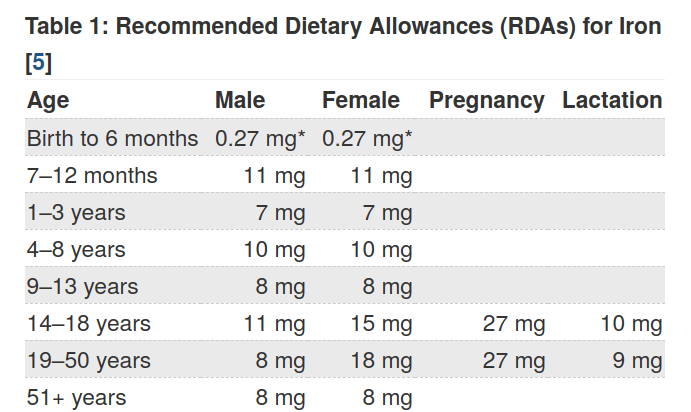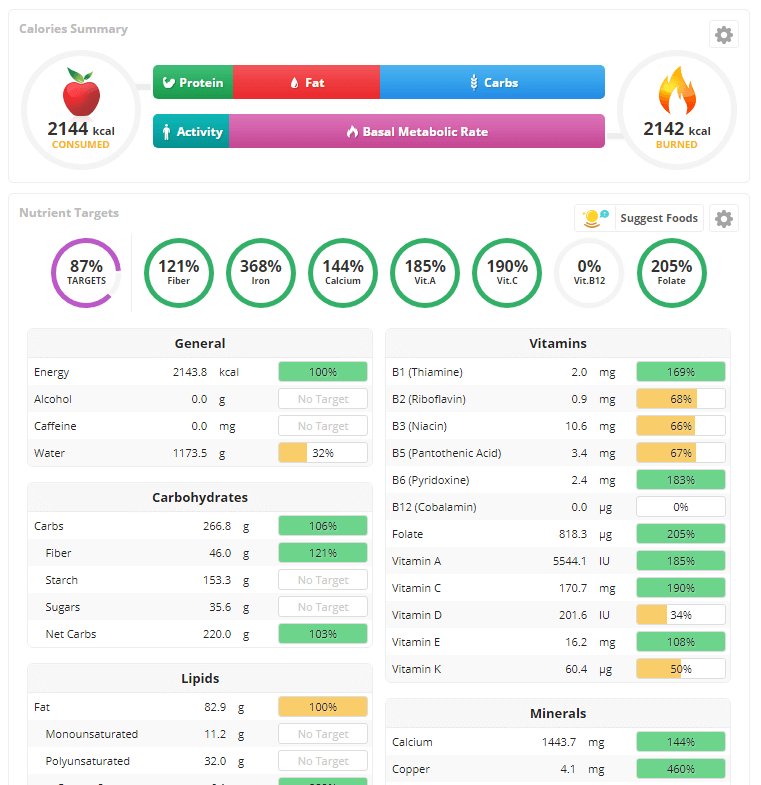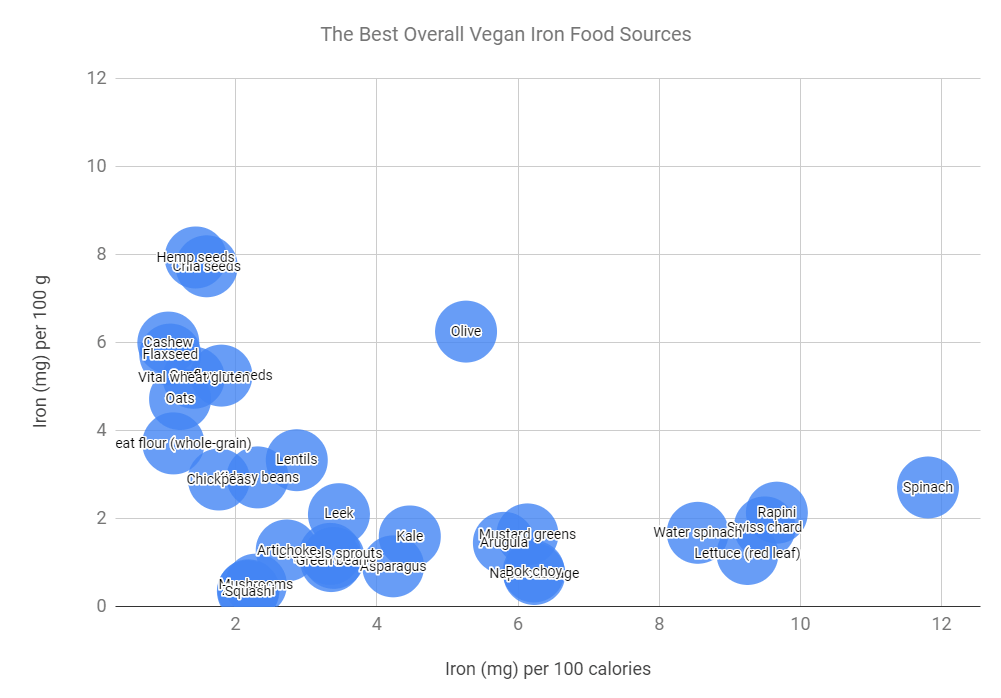Most people know that most of the best sources of iron are animal products like red meat.
That’s why it’s not too surprising that iron is one of the most common deficiencies among vegans (1).
To help you, I’ve compiled a list of the best vegan sources of iron, in a few different formats to make the data as useful as possible.
I only included “whole” plant foods, so nothing like fortified cereal even though it can have quite a bit of iron.
Finally, there’s a section near the end that will tell you what you need to do to maximize iron absorption, which is especially important for vegans. Once you’re done here, you might want to check out the best vegan sources of calcium, as calcium deficiency is also relatively common.
Table of Contents
How Much Iron Do You Need?
It’s possible to be iron deficient on a vegan diet if you’re not eating iron-rich foods. The first signs of this are:
- Fatigue
- Paleness
- Headaches
- Dizziness
- Heart palpitations
- Feeling cold
- Weakness
If you’re lacking iron for a long time, you can develop iron deficiency anemia as your iron stores deplete.
How much iron do you need per day? According to the NIH, It depends on your age, gender, and size, but for most adults it’s around 8-18 mg per day. (Source)

The necessary iron intake for women is a lot higher than men (because you lose iron when you bleed).
The Best Overall Vegan Iron Sources
Here’s a quick visualization that I find useful for a topic like this.
Below is a simple bubble chart that compares the amount of iron in a food to the number of calories it has (click to enlarge). Note that these are the good sources of iron overall, many foods are omitted because they don’t make the cut.
- Foods in the bottom right – Leafy greens like spinach have a lot of iron per calorie, but very little per 100 grams, meaning you need to eat a ton of them to get a lot of iron. Good if you’re trying to lose weight.
- Foods in the top left (e.g. seeds, nuts, oats) have a lot of iron per 100 grams, but also a lot of calories. Good if you’re trying to gain weight, but can be an issue otherwise.
- Foods in-between the 2 extremes (e.g. olives, lentils, chickpeas, beans) – These are all in that “middle” area between each axis. They have a good balance between calories and iron density. Good if you’re trying to maintain weight.
Best Vegan Iron Rich Foods Per 100 Grams
The standard way to look at nutrients in food is per 100 grams, which I’ve done below.
Here’s a list of the top 30 vegan sources of iron per 100 grams.
| Food | Iron (mg) per 100g |
|---|---|
| Seaweed (dried) | 28.6 |
| Sesame seeds | 14.6 |
| Hemp seeds | 7.9 |
| Chia seeds | 7.7 |
| Olive | 6.3 |
| Cashew | 6.0 |
| Flaxseed | 5.7 |
| Pine nuts | 5.5 |
| Sunflower seeds | 5.3 |
| Vital wheat gluten | 5.2 |
| Oats | 4.7 |
| Hazelnut | 4.7 |
| Peanuts | 4.6 |
| Pistachio nuts | 3.9 |
| Wheat flour (whole-grain) | 3.7 |
| Almonds | 3.7 |
| Macadamia nut | 3.7 |
| Lentils | 3.3 |
| Pumpkin seeds | 3.3 |
| Kidney beans | 2.9 |
| Walnut | 2.9 |
| Chickpeas | 2.9 |
| Spinach | 2.7 |
| Rye grain | 2.6 |
| Pecans | 2.5 |
| Soybeans | 2.5 |
| Buckwheat groats | 2.5 |
| Lima beans | 2.5 |
| Brazil nut | 2.4 |
| Coconut meat | 2.4 |
Seeds and nuts dominate the top portion of the list.
The only downside of those sources is that they also have a lot of calories.
If you’re concerned with calories, move on to the final table below.
Best Vegan Iron Rich Foods Per 100 Calories
If you’re on a limited calorie intake, it may be more useful for you to look at the amount of iron per 100 calories of each food.
Again, here are the top 30 in this category.
| Food | Iron (mg) per 100 cal |
|---|---|
| Spinach | 11.8 |
| Seaweed (dried) | 10.0 |
| Rapini | 9.7 |
| Swiss chard | 9.5 |
| Lettuce (red leaf) | 9.3 |
| Water spinach | 8.5 |
| Napa cabbage | 6.2 |
| Bok choy | 6.2 |
| Mustard greens | 6.1 |
| Arugula | 5.8 |
| Olive | 5.3 |
| Kale | 4.5 |
| Asparagus | 4.2 |
| Leek | 3.5 |
| Turnip greens | 3.4 |
| Green bean | 3.4 |
| Brussels sprouts | 3.3 |
| Lentils | 2.9 |
| Artichoke | 2.7 |
| Sesame seeds | 2.5 |
| Kidney beans | 2.3 |
| Mushrooms | 2.3 |
| Zucchini | 2.2 |
| Squash | 2.2 |
| Broccoli | 2.1 |
| Amaranth | 2.1 |
| Lemon | 2.1 |
| Bamboo shoot | 2.1 |
| Lime | 2.0 |
| Radish | 2.0 |
Leafy greens dominate this table, but keep in mind that it will take multiple servings of most of these to get to 100 calories.
Note that kidney beans, lentils, and sesame seeds still rank well on this list, in addition to the earlier tables, which shows they’re a very practical way for most people to avoid an iron deficiency.
Best Vegan Food Sources of Iron Per Serving
Using a few food databases, I compiled a list of vegan foods that have significant amounts of iron in them.
For the table below, it’s all done on a per typical serving basis.
| Food | Serving size | Calories | Iron (mg) |
|---|---|---|---|
| Sesame seeds | 1/2 cup | 412.5 | 10.45 |
| Oats | 1 cup | 607 | 7.4 |
| Cashews | 50 g | 276 | 6.7 |
| Lentils | 1 cup (cooked) | 230 | 6.6 |
| Hemp seeds | 3 tbsp | 170 | 5.3 |
| Kidney beans | 1 cup (cooked) | 219 | 5.3 |
| Amaranth | 1 cup | 251 | 5.2 |
| Chickpeas | 1 cup (cooked) | 269 | 4.7 |
| Navy beans | 1 cup (cooked) | 255 | 4.3 |
| Coconut milk | 1 cup | 552 | 3.9 |
| Black beans | 1 cup (cooked) | 227 | 3.6 |
| Quinoa | 1 cup | 222 | 2.8 |
| Tofu | 1/2 block | 113 | 2.6 |
| Pistachios | 1/2 cup | 351 | 2.6 |
| Peas | 1 cup (cooked) | 134 | 2.5 |
| Tempeh | 1/2 cup | 160 | 2.25 |
| Kale | 2 cups | 66 | 2.2 |
| Pumpkin seeds | 1 cup | 285 | 2.1 |
| Spirulina | 1 tbsp | 20 | 2 |
| White potato | 1 large potato | 281 | 1.9 |
| Brussel Sprouts | 6 sprouts | 48 | 1.8 |
| Almonds | 1/2 cup | 273 | 1.75 |
| Walnuts | 1/2 cup | 382.5 | 1.7 |
| Peanuts | 1/2 cup | 427 | 1.65 |
| Spinach | 2 cups | 14 | 1.6 |
| Parsley | 1 tbsp | 4 | 1.5 |
| Spearmint | 1 tbsp | 4 | 1.3 |
| Thyme | 1 tbsp | 1 | 1.2 |
| Broccoli | 1 small stalk | 98 | 0.9 |
| Cocoa powder | 1 tbsp | 196 | 0.7 |
| Flaxseed (whole) | 1 tbsp | 54.7 | 0.6 |
| Peanut butter | 2 tbsp | 188 | 0.6 |
| Tomatoes | 1 large | 33 | 0.5 |
| Oregano | 1 tsp | 3 | 0.4 |
| Mushrooms | 1 cup | 15.4 | 0.3 |
| Basil | 1 tsp | 1 | 0.2 |
I think iron per serving is the most useful information to most people, but there are a few other ways we can look at the data.
Many of these vegan foods are high in iron and protein, which covers 2 things that people often struggle with getting enough of from plants.
The 3 Main Types of Plant Foods That Are High in Iron
The table and graphs above are not 100% complete, but I included every vegan food I could find or think of that has iron.
It’s a good idea to think of the general types of foods that have iron when you’re planning your meals, of which there are 3 main categories.
Vegetables (Mainly green ones)
Vegetables have a reasonable amount of iron, but very few calories. The top ones from above are:
- Spinach
- Brussel Sprouts
- Kale
- Mushrooms
- Tomatoes
The big issue with them is that it’s hard to eat a lot of them.
So try to include them when you can, but understand that you’re unlikely to get 100% of your iron from them unless you eat 10 salads a day.
Nuts and Seeds
Nuts and seeds are relatively high in calories, but also have a high iron content.
The biggest benefit of them is that it’s easy to eat a lot of nuts, although the calories add up fast.
The best nut and seed sources are:
- Sesame seeds
- Cashews
- Flaxseed
- Pistachios
Legumes (Beans, lentils, etc)
Legumes are a nice balance of both of the above categories.
They have a high iron content (and nutrients in general), and can be eaten in fairly large quantities without adding too many calories to your diet.
This is where I get the bulk of my iron, and I’d recommend you do the same.
The best sources from above are:
- Kidney beans
- Tofu
- Navy beans
- Black beans
- Lentils
- Peas
Iron Absorption is Lower From Plant Foods
There are 2 types of iron: heme and non-heme iron.
Animal foods (e.g. red meat) have a mix of both, while plant based iron is only non-heme.
Unfortunately, we don’t absorb non-heme iron as well, which is why vegetarians and vegans have to pay more attention to iron deficiency than meat eaters. Otherwise, you can think you’re getting enough iron, but still end up with anemia.
But there are a few things you can do to improve how well you absorb the iron in your food and raise your iron levels:
- Eat it with vitamin C – Absorbic acid (vitamin C) has been shown to improve the bioavailability of non-heme iron in studies. Add lemon (juice) to your meals, or eat a fruit with vitamin C with the foods on this page to increase iron absorption. Here’s a list of vitamin C rich foods that are vegan-friendly.
- Soak your legumes – Soaking your beans improves the bioavailability of many nutrients, including iron (it reduces antinutrients like phytic acid, a.k.a phytates, that bind to nutrients like iron and reduce absorption). You’ll still get some, just not as much.
- Consume enough lysine – Lysine is required to digest non-heme iron well. Studies have shown that eating foods high in lysine improves iron absorption. This is important to prevent hair loss as well.
How to Track Your Iron Intake
To wrap things up, one final thing I’d like to mention is a food tracking app called Cronometer.
It breaks down all the food you eat and makes it easy to see if you’re getting enough of each nutrient (both vitamin and mineral content), iron included.

Here’s my full Cronometer review if you’d like to learn more about it.
I’d recommend tracking your diet for a few weeks to see your iron status, and once you’re comfortable it’s up to you if you’d like to continue.
If you just can’t get enough dietary iron, or it’s too inconvenient, there are many vegan iron supplements that can help. Here’s a list of the top vegan iron supplements if you’d like to learn more about this option.
Also, if you do need help incorporating some of these foods in your meals, here’s a list of 12 vegan recipes high in iron.
Finally, if you have a good reason to be worried about your iron levels (i.e. past history or anemia), go see your doctor and get blood tests done on a regular basis.

